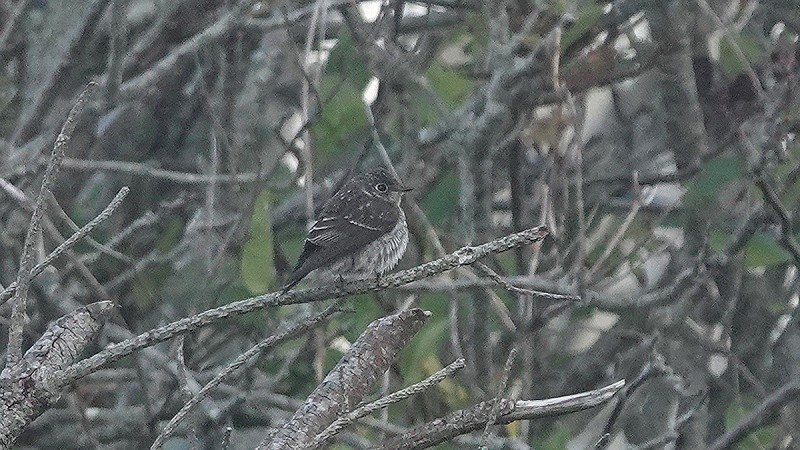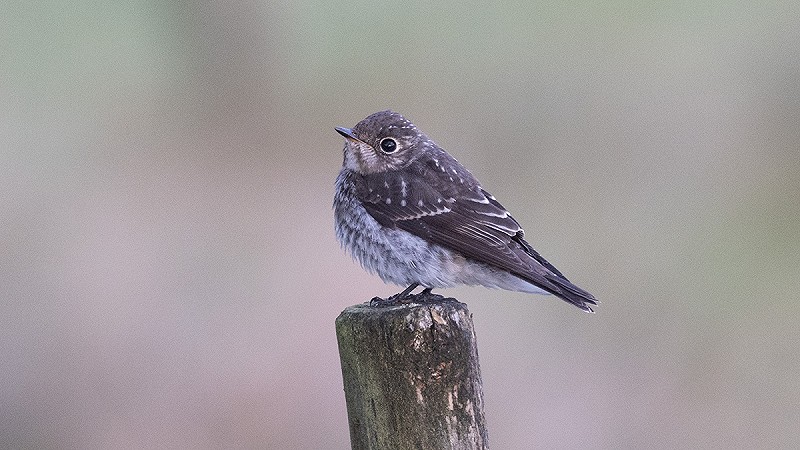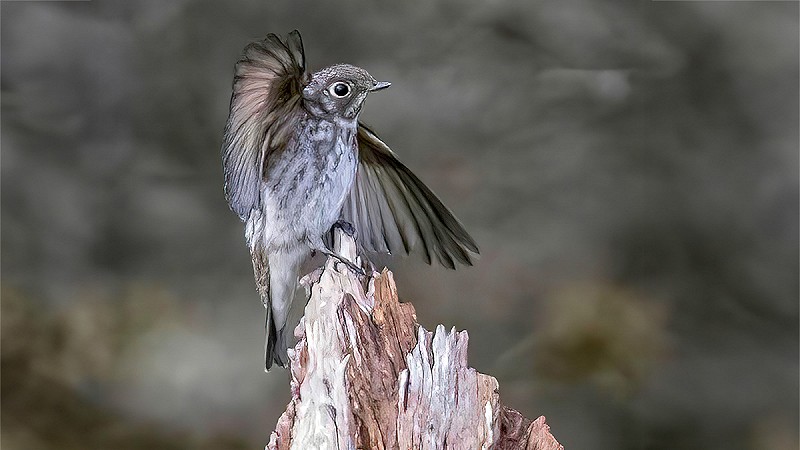Dark-sided Flycatcher on Herdlevær, Norway, in October 2023
21 October 2023 · Bert de Bruin · 4820 × bekeken
I often visit Herdlevær along the coast in south-western Norway. It is a very small island at c 45 min driving time from Bergen, Vestland, where I live. Needless to say, I do so in search of birds, especially small, rare birds. On 5 October 2023, I did my round there. It was nice birding with fresh arrival of migrants. I heard two Yellow-browed Warblers Phylloscopus inornatus and saw Goldcrests Regulus regulus, European Robins Erithacus rubecula, a Eurasian Blackcap Sylvia atricapilla and a Common Chiffchaff P collybita. On the western part of the island, I met Julian Bell, who is a regular there as well. Together we walked back to our cars. We stood a while at the so-called ‘rarity garden’ when Julian noticed a flycatcher. We saw the bird together very briefly but it looked strange, seemingly with a lot of dark spots. It flew off and we had difficulties getting good views - but we were alarmed! It flew a lot and was erratic. Still, Julian managed to get some photographs with his superzoom camera. These showed a dark flycatcher with a lot of white feather tips on the upperside and the underside was quite mottled. We assumed that it had to be a Spotted Flycatcher Muscicapa striata in unusually late juvenile plumage, because of the white-tipped feathers on the upperparts. After a short while, I relocated it higher up in some trees, catching flies as flycatchers do, and obtained some more photographs. We were quite puzzled, and I mentioned a few times the possibility of an East-Asian straggler, Grey-streaked Flycatcher M griseisticta or ‘that other flycatcher from East Asia’, which name I could not remember at that moment. But that would be far-fetched…
 Dark-sided Flycatcher / Roetvliegenvanger Muscicapa sibirica, first-year, Herdlevær, Vestland, Norway, 5 October 2023 (Julian Bell). Shortly after first sighting.
Dark-sided Flycatcher / Roetvliegenvanger Muscicapa sibirica, first-year, Herdlevær, Vestland, Norway, 5 October 2023 (Julian Bell). Shortly after first sighting. Julian had to leave to catch a plane, still thinking we had seen a strange Spotted Flycatcher...! But I took a better look at my photographs, which made me feel very uneasy. Such a mottled bird with such an obvious eye-ring could not be a Spotted... I needed help and decided to text Eirik Adolfsen, Frode Falkenberg and Terje Hansen, sending one of my photographs along with the message. I contacted my brother Sybrand de Bruin and Enno Ebels in the Netherlands as well. And off it went! Eirik and Terje were not far away and they arrived after 20 min, together with Jørn Opsal. The first thing Eirik said was that we had found ‘en bombe’ (Norwegian for a very rare bird). Frode was at home and could check literature, which Sybrand and Enno could do as well. Of course, I lost the bird in the process, but Eirik refound it after c 30 min. Meanwhile, a very alarmed Frode and Enno reminded me of ‘that other flycatcher’, Dark-sided Flycatcher M sibirica and Enno sent images of the record in Iceland in October 2012. Our bird seemed settled and I decided to put the news out on the local rarity system Band after Julian sent us some better photographs than I had. In the message, I asked for help to put a name on this bird as either Grey-streaked or Dark-sided. Sybrand posted an image on the Facebook group ‘European bird identification’. All of those who responded were convinced that it was in fact a fine juvenile Dark-sided. I still couldn’t believe what we had found... But later on the day, after contacting Julian and checking photographs and literature, I settled definitely for Dark-sided: new for Norway and only the second for the Western Palearctic. It stayed to 10 October and was seen by many birders from Norway and some from abroad.
It was a rather cold grey and dark Muscicapa, smaller than Spotted Flycatcher, with a short tail and very long wings (estimated c 120% of tertial length based on photographs) and reaching about half of the tail, well beyond the tips of the uppertail and undertail coverts. It had a marked facial expression with a distinctive eye-ring around the big eye, most obvious behind the eye. The lores were darkish brown, the same colour as the crown. The ear-coverts were grey and mottled/striped off white. The chin and throat were pale grey with strong lateral stripe. The underparts were mottled, especially on the breast-side and flank. The centre of the breast and belly were off-white without obvious markings. The undertail-coverts were slightly mottled, not as obvious as on the flank. The upperparts were cold grey (paler grey in direct sunlight), many feathers having whitish spots on the feather tip on crown, shoulders, back, rump, lesser wing-coverts and greater wing-coverts, the latter forming an off-white wing bar. The tertials showed broad whitish fringes. Pale fringes were present on the visible secondaries, forming a pale secondary field. On the lower back and rump, many feathers had a whitish tip. The uppertail was dark as the upperparts, with thin pale fringes to the feathers. The underwing-coverts were rusty brown, and the rest of the underwing was dark grey. The bill was broad, triangular but short (about as broad as long), dark with little yellow only at the base of the lower mandible yellow reaching to one third of the lower mandible and difficult to see in the field. The legs were dark grey. When found, it was erratic and flying around a lot and sitting a few times high up in some trees. Later, it was often sitting quietly in some apple trees or spruce trees and sallying (catching flies during short quick flights), typically like a flycatcher. During its stay, no sound was heard.
 Dark-sided Flycatcher / Roetvliegenvanger Muscicapa sibirica, first-year, Herdlevær, Vestland, Norway, 6 October 2023 (Alf Alden)
Dark-sided Flycatcher / Roetvliegenvanger Muscicapa sibirica, first-year, Herdlevær, Vestland, Norway, 6 October 2023 (Alf Alden)It was clear from the start that it was a Muscicapa flycatcher. Spotted Flycatcher, even in delayed juvenile plumage, can be ruled out on structure and plumage details. Spotted would show pale spots on the upperparts in juvenile plumage but our bird was too dark, had a shortish tail, very long wings, a bold eyering and mottled underparts and lacked the fine stripes on the crown and breast of Spotted. Therefore, the choice was between the migratory East Asian flycatchers, ie, Asian Brown M dauurica, Grey-streaked and Dark-sided Flycatcher. Asian Brown could be ruled out because of the small bill without conspicuous yellow at the base, too well marked upperparts and underparts and the very long wings. The next to rule out was Grey-streaked, that can strongly resemble Dark-sided. Grey-streaked was ruled out, because our bird had mottled underparts, not streaked. Further, it showed mottled undertail-coverts and still had juvenile feathers on the upperparts, which is typical for Dark-sided. In all, our bird could safely be identified as a first-year Dark-sided (Birding World 4: 271-278, 1991, Br Birds 103: 658-671, 2010, Br Birds 84: 528-542, 1991).
 Dark-sided Flycatcher / Roetvliegenvanger Muscicapa sibirica, first-year, Herdlevær, Vestland, Norway, 9 October 2023 (Roald Hatten)
Dark-sided Flycatcher / Roetvliegenvanger Muscicapa sibirica, first-year, Herdlevær, Vestland, Norway, 9 October 2023 (Roald Hatten)Dark-sided Flycather Breeds in East Asia. It has four subspecies: sibirica, gulmergi, cacabata and rothschildi. The latter three breed around the Himalaya, eastwards form eastern Afghanistan and southern China and are short-distance migrants to their wintering grounds. Sibirica breeds in eastern Siberia, Russia, through Mongolia, China and northern Japan and winters in Taiwan, Indochina and northern Borneo (www.birdsoftheworld.com). The species is rare but regular in spring (mid-May to late June) on the Aleutians and Pribilofs, Alaska, USA. Vagrants have been recorded on Bermuda in September 1980 (Auk 100: 212-213, 1983) and on Iceland in October 2012 (Dutch Birding 42: 113-115, 2020). If accepted, this is the first record for Norway and the second for the Western Palearctic.
Thanks go to Eirik Adolfsen, Alf Alden, Sybrand de Bruin, Enno Ebels, Frode Falkenberg, Cecilie Hansen and Roald Hatten.
Bert de Bruin, Bergen, Norway (bedebe@gmail.com)
Discussie
Sybrand de Bruin
·
21 October 2023 08:45, gewijzigd 21 October 2023 08:47
Een heerlijke vondst natuurlijk. Was een genoegen om, helaas op afstand vanuit Nederland, enigszins te helpen bij het op naam brengen. MFM, een heel romantische soort waar je eigenlijk nooit aan denkt te kunnen vinden wanneer je (daar in Noorwegen, of elders in de WP) aan durft te denken.
Jan van der Laan
·
21 October 2023 12:15
Goed gedaan, Bert! Hopelijk komt de vogel nog deze kant op. Sybrand die hem vindt bijvoorbeeld.
Wim Wiegant
·
21 October 2023 20:11, gewijzigd 21 October 2023 20:12
Wat een heerlijk verhaal...!
En, laten we maar eerlijk zijn, wat een romantische vogel.
Gefeliciteerd met deze ultraknaller, én met het mooie verhaal erover...!
Gijsbert van der Bent
·
22 October 2023 12:28, gewijzigd 22 October 2023 12:29
Zeker een romantische vogel. En eentje waarvan de Nederlandse naam toch echt mooier is dan de Engelse: Roetvliegenvanger! Goed beschouwd zijn die Engelse namen toch ook vaak raar als je ze letterlijk vertaalt. Dark-sided?
Dušan Brinkhuizen
·
25 October 2023 20:04
Petje af Bert et al.!
Bert de Bruin
·
31 October 2023 08:05, gewijzigd 31 October 2023 09:22
Bedankt allemaal voor de leuke reacties, veelal buiten dit forum om. Ik heb hem nu ingediend bij de Noorse commissie (NSKF) en het artikel voor Vår Fuglefauna geschreven. Gelukkig heeft Frode Falkenberg er leesbaar Noors van gemaakt;-)...hier de netversie
Wim Wiegant
·
2 November 2023 15:50
Nog een vraagje, Bert: ben je nog Nederlander, of ben je nu Noor, en ben je een voormalige Groninger...? Ik moét het nu weten...! En Julian Bell, is dat een Noor, of heeft hij een andere nationaliteit.
Allemaal (korte) vragen, die zonder antwoord niet goed behandeld kunnen worden in het DB Terugblik-maandoverzicht...
Bert de Bruin
·
2 November 2023 19:35
Wim, ik ben nog steeds Nederlands (en voormalig Groninger) en zal dat ook wel blijven. Julian Bell is een Engelsman. Succes met je overzicht, ik lees het altijd met genoegen!!
Arnoud B van den Berg
·
5 October 2024 23:42
Jij was tóch eerder, Bert!
Gebruikers van het forum gaan akkoord met de forumregels.

